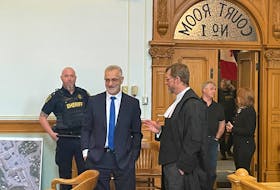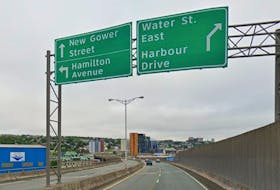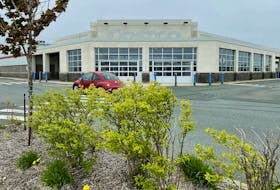ST. JOHN'S, N.L. — Oh, if those Duckworth Street walls could talk, they’d spill the tales of women toiling away at making suits and trying to strike for fair wages, of the somewhat mysterious exit of a prominent industrial family, of young reporters clashing with outdated mores and of a young printer’s composer destined for greater things.
Those are just a few, because there are hundreds of stories hushed within the walls at 275 Duckworth St., as the building shifted from one use to another, or stood empty for years, evolving from factory, to newspaper office, to restaurants, to private college, to a creative space for craftspeople and a proposed boutique hotel.
The Evening Telegram is probably the best-known occupier of the building from the 1950s-’80s. But the history of it didn’t start, nor end, there.

Hoping to collect and display that eclectic history, the Craft Council of Newfoundland and Labrador and Heritage NL are hosting a reunion in August of everyone who worked in the building, with the aim of gathering their stories, as well as any photos they have from their time there.
It was built around 1910-11 for the Newfoundland Clothing Co., which employed tailoresses to make suits, while the cardboard box factory in the basement fabricated the boxes in which to ship them. The tender went out in June 1910, and the factory was opened with a grand ball and supper in November 1911.
When The Evening Telegram left in the 1980s, it had a variety of uses, including some food establishments such as The Dallas Lounge. In later years, it was CompuCollege.
Now a local developer is waiting on permits to turn the top floors into a boutique hotel, while the craft council occupies the lower section.
Mary McKim was one of the few women to grace The Evening Telegram newsroom when she arrived there in the late 1960s — her mother, then women’s editor Eleanor McKim, was also among the minority.
Young McKim, who started as a summer intern and took a full-time job in the spring of 1969, would be the first female reporter to cover the provincial budget. (The lock-up — a session before the budget is presented in the House of Assembly, in which reporters go over the details and ask questions — was held in an area of Confederation Building without a women’s washroom.)
“I was pretty bright-eyed and bushy-tailed,” McKim recalled, dishing stories of hanging out the third-floor newsroom window with fabled columnist Ray Guy to watch the ladies of the evening stroll along the street.
The Evening Telegram at the time had a morning deadline, and when the press started up in the basement, the entire building would shake. Compositors used lead type to set the print for the newspaper pages.

McKim said an early lesson in the role of journalism in democracy was when the then-legislative reporter called the newsroom and an editor yelled out, “Stop the presses.”
John Crosbie had crossed the floor in defiance of then-Liberal premier Joey Smallwood.
"It was something akin to the second coming,” she said of the decision to remake the front page.
But it wasn’t always a democracy for women in the workplace.
McKim rode a Honda scooter to work, and when she first showed up in a pantsuit, she was called up to the fourth floor where the owners, the Herders, had their executive offices.
“I was told that I could not wear pants and be a representative of The Evening Telegram,” McKim recalled.
So, at the start of each shift, she had to go in the ladies’ washroom and change from her pants to a miniskirt.
The scooter played a role in one of the most memorable stories from McKim’s time there — which ended in the early 1970s and continued with a stint at The Evening Telegram on Columbus Drive in the 1980s. She is also a former CBC journalist.

McKim was working a night shift one night by herself — the sports guys had gone out for a late meal of fish and chips around 11 p.m.
As a junior reporter, McKim’s desk was close to the counter where people would drop off news releases. She heard the elevator coming up to the third floor, and when the doors opened, no one got off.
“My scooter was in the elevator,” McKim recalled.
She taped a note to it and sent it back to the first floor, ordering the jokesters in the sports department to put it back on the sidewalk, which they did.
McKim, a folk singer in her spare time, was at a club one night and recognized a co-worker — a young man playing guitar.
It was Gordon Quinton, and they went on to play some gigs together.
Quinton, a brilliant guitarist, had moved with his family from Grand Falls and wasn’t sure what to do for work, so he took a printing course at trade college.
He then took a job at The Evening Telegram, working in the composing room in the basement.
“I don’t know if I worked there very long, a year at the most,” said Quinton.
“I was pretty young, 18 or 19.”

He lived on Monroe Street and would walk to work, punching a time clock inside the doors of the entrance across the lane from what is now The Ship Inn. Any time he plays a gig there, it brings back memories.
Quinton was playing a number of evenings, and decided to pursue music full time. He soon became a member of the band for CBC’s “All Around the Circle.”
When Bob Wakeham, a Telegram columnist and retired CBC producer, first walked through those Duckworth Street doors in 1972, he felt like he was walking into a silver screen newsroom movie set — 1930s-’40s films like “The Front Page” and “His Girl Friday” — a description pretty similar to McKim’s first impressions.
The place was alive with noise and clatter — in the third-floor newsroom it was the clanging portable typewriters, the non-stop ringing phones, the whirring wire machines and the blue language of the mostly male editorial staff at work in an ever-present haze of cigarette smoke.
In the basement, there was the loud rumblings of the press and the steady work of dozens of composers setting up pages alongside the linotype machine.

“You had to be able to read upside down and backwards,” McKim said of the machines.
On the third floor, there was a massive, old-fashioned horseshoe desk where the editors sat, Wakeham said.
“It was really old-timey,” said McKim. “The editors had the green shade things on their heads, just like in an old Dick Tracy movie. “
“The beat-up typewriters looked like they must have survived Beaumont Hamel,” said Wakeham, who often frequented Ray Guy’s office, where Guy had a collection of headlines on the wall. One was a typo that omitted the letter W and used the letter T instead, and read, “12 inches of snot falls on St. John’s.”
On sweltering summer days, Guy and others would take their typewriters out on the adjoining roof to work and catch a breeze from the harbour.
Just like McKim, Wakeham knew that if you were called to the fourth floor, it wasn’t good.
He was once spoken to for having a hole in his shoe while interviewing then-premier Brian Peckford. No raise was forthcoming, though, to help with the purchase of a new pair — just an order to go back to the newsroom, when he defended himself.
Lunches were often spent at Dirty Dick’s across the lane, in what is now the Ship Inn.
“We’d go en masse to the bar. … We drank hard and we worked hard, too,” said Wakeham, who left The Evening Telegram after eight years.
The personal stories are what’s missing as the craft council and Heritage NL compile the history of the building, said Dale Jarvis, intangible cultural heritage development officer.
Hopefully, he said, the reunion will give them an opportunity to follow up with some interviews to document the oral history. The plan is to display some storyboards in the craft council’s premises.
“You wouldn’t know all the incredible stories that took place in that building by just walking in,” Jarvis said, adding the renovations that have taken place over the years leave no hint of its earlier uses.
They also hope to meet some of the descendants of the tailoresses who worked in the factory.
Rachel Green, the intern tasked with investigating and compiling the history, said 275 Duckworth mirrors the shift in the history of St. John’s from its industrial beginnings to its current functions. She has been digging through archival material and old directories, and has even tracked down a descendant of the family that started the clothing factory.
Stephanie Dennis, a teacher in London, U.K., was already planning a first-ever vacation to Newfoundland this summer, when she learned of the reunion.
She had been working on the family history for the last 20 years, and still has questions about some of the family background — the family attempted unsuccessfully to establish a similar business in Leeds more than 100 years ago. There is also the circumstances in which the family left St. John’s.
Her great-great-grandfather, who had come to St. John’s from Newark, N.J., died without a will while travelling in Europe, leaving his son, Moses, to deal with challenges from his father’s siblings in the U.S. and having to buy the Newfoundland business back from them.
Moses built the Duckworth Street building, which was to employ hundreds and produce suits for the domestic market.

In 1912, the tailoresses, according to “Feminist Research: Prospect and Retrospect” by the Canadian Research Institute, tried to strike for protection under minimum-wage legislation. Some got work with other factories and others were forced back to work without concessions.
Sometime around 1913, Moses Mayers’ house on Allandale Road mysteriously caught fire, and he sold off everything that could be salvaged from it, along with the land, and headed to Leeds.
“It’s very strange. One moment it’s a thriving factory … a few years down the line, he’s taken the family to Leeds,” said Dennis, who nevertheless is thrilled with her connection to someone who had the vision to build such a factory.

Although he came back and tried, unsuccessfully, to establish another business in St. John’s around the 1920s, Moses Mayers died in 1931 in London, having lost his money in the Depression, Dennis said.
But Dennis said her father, Michael, grew up with tales of his family having once lived in a grand house.
The factory, without the Mayers, continued into the 1950s, according to information compiled in connection with the reunion.
Dennis said she was thrilled to find out the building still exists, and she will get to see it in August.
Vic Lawlor, owner of the building, said he hopes to call the hotel — still waiting on permits — The Factory Hotel.
“That feels very poetic,” said Dennis, who booked her and her husband’s trip in January, long before news of the reunion.
“It just feels like this trip was meant to be. Everything else has fallen into place. It seems incredible.”
Lawlor has owned the building for three years, after it was vacant for an extended period. He has been waiting on permits, he said, for a year and a half.
“It’s crazy,” he said.
Nonetheless, Lawlor remains intent on his plans, and expects to display some of the history he uncovered during initial work — such as a First World War victory bond and pieces of the old metal ceiling.
“At one time there were 400 Newfoundland women and men working as seamstresses in there. That’s amazing,” he said.
The reunion takes place Aug. 1 at 7 p.m. at the craft council’s art gallery.
Anyone who has questions, or a memory of the building they want to share, can contact Rachael Green at [email protected] or call toll-free 1-888-739-1892 ext 6
Twitter: @BarbSweetTweets









